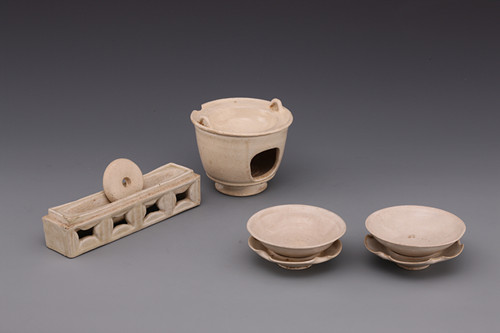 |
|
White glaze tea sets from the Tang Dynasty (618-907). [Photo/people.cn] |
Chinese tea art was born in the Han Dynasty (206BC-220AD), matured in the Song Dynasty (960-1279) and flourished in the Ming and Qing dynasties (1368-1911). From a simple beverage it became a cultural and spiritual icon, symbolizing a noble character. Accordingly, tea sets varied with the changes in ethos at different time and become more artful with a scent of humanization.
In general, tea sets become smaller and simpler after many changes throughout history. There are few records of tea sets before the Tang Dynasty (618-907). However, the tea art bloomed after Lu Yu's Cha Jing (The Classic of Tea) came out in the Tang Dynasty, with 28 tea sets mentioned in one chapter.
The tea sets in the Tang Dynasty are simple and unsophisticated while the ones in the Song Dynasty are more gorgeous and magnificent. Tea bottle replaced water boiler. And "cha xian" (functions as a spoon to blend tea) was added in tea sets. A competitive game based on tea drinking enjoyed a great popularity during this time. The invention of tea bottle and "cha xian" were just for the game. The tea bottle used in the game often has a big belly and long slim neck with a parabolic shaped mouth, which can control the water better when filling a cup. Cups made of black glaze were highly recommended, because its color matches the tea better and can tell if the quality of the tea is good enough. And the thickness of the cup can help to keep the tea warm.
In the Ming and Qing dynasties, tea sets returned back to simpler terracotta and china from their gold and silver predecessors. But these simple tea sets are much more artful and sophisticated than the ones in the Tang Dynasty.
To test the color of the tea, white colored tea sets were more favorable, because loose tea that is similar with the modern roasted green tea popularized instead of compacted tea during this period. The green color of the loose tea and white tea cup can set off each other beautifully. What's more, people tended to put boiled water in tea rather than boiling the tea directly as before.
Apart from tea sets made of white china, purple clay pottery made in Yixing of Jiangsu province flourished in the Qing Dynasty. It is said that tea made by Yixing's purple clay tea sets still tastes good after being kept in the pottery for one night even in hot summer.